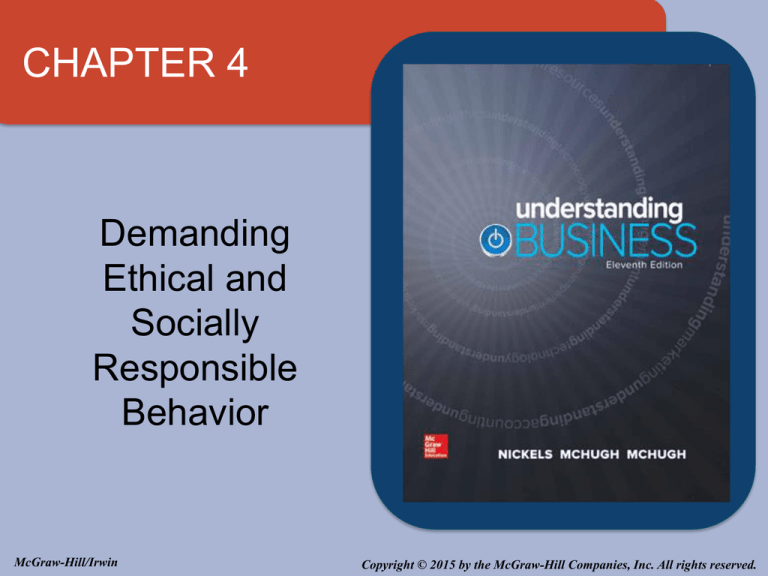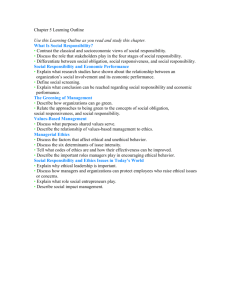
CHAPTER 4
Demanding
Ethical and
Socially
Responsible
Behavior
McGraw-Hill/Irwin
Copyright © 2015 by the McGraw-Hill Companies, Inc. All rights reserved.
Ethics and Social Responsibility: A
Close Relationship
ETHICS
Beliefs about
right and wrong
SOCIAL
RESPONSIBILITY
The obligation of a business
to contribute to society
(businesses concern for
welfare of society)
4-2
WHAT are ETHICS?
LO 4-1
Ethics
• The study of right and wrong and of the
morality of the choices individuals make
• An ethical decision is one that is “right”
according to some standard of behavior
What’s Ethical?
• Different standards for different people,
cultures, countries, etc.
• Gray areas?
• More than just following the law
• Fundamental standards (respect for life,
honesty, integrity, etc.)
Business ethics
• The application of moral standards to
business situations
Good ethics is good business!
• The application of moral standards to
business situations
4-3
BASIC MORAL VALUES
Right:
• Integrity
• Respect for human life
LO 4-1
Wrong:
• Cheating
• Cowardice
• Cruelty
• Self-control
• Honesty
• Courage
• Self-sacrifice
4-4
UNIVERSAL ETHICAL STANDARDS
Fairness and honesty
• Businesspeople are expected to refrain from knowingly deceiving,
misrepresenting, or intimidating others.
• Follow the “Golden Rule” (treat other people like you want to be treated)
Organizational relationships
• A businessperson should put the welfare of others and that of the
organization above his or her own personal welfare.
Conflict of interest
• Issues arise when a businessperson takes advantage of a situation for
personal gain rather than for the employer’s interest.
Communications
• Business communications that are false, misleading, and deceptive are
both illegal and unethical.
FACTORS THAT INFLUENE ETHICAL
BEHAVIOR
Three general sets of factors appear to influence the standards of behavior in an
organization.
•Individual factors
• Individual knowledge of an issue
• Personal values and beliefs
• Personal goals
•Social factors
• Business Climate (managers, co-workers)
• Cultural norms, attitudes and beliefs
• Religion
• Significant others
• Co. Enforcement
• Code of Ethics
• Co. Policies (ex. Use of the Internet)
•Opportunity
• Presence of opportunity
4-6
ETHICS and YOU
LO 4-2
• Plagiarizing from online
materials is the most
common form of cheating
in schools today.
• Studies found a strong
relationship between
academic dishonesty and
dishonesty at work.
4-7
FACING ETHICAL DILEMMAS
LO 4-2
• Ask yourself these
questions:
- Is it legal?
- Is it balanced?
- How will it make me
feel about myself?
4-8
BRIBERY BAD BOYS
LO 4-2
Five FCPA Investigations
Company
Case
Smith and Wesson
Improper payments to foreign officials.
Stryker
Corporation
Bribing doctors and government officials in five
countries.
Hewlett-Packard
Improper payments for contracts.
Bio-Rad
Laboratories
Subsidiaries made improper payments to officials in
Russia, Vietnam, and Thailand.
Diebold
Bribed officials at government-owned banks.
Source: SEC, www.sec.gov, accessed November 2014.
4-9
ETHICS START at the TOP
•
Organizational ethics begin at the top.
•
Managers can help instill corporate values in employees.
•
Trust between workers and managers must be based on
fairness, honesty, openness and moral integrity.
LO 4-3
Individuals must make their own
ethical choices
BUT
The organization can have a significant influence
on decisions
4-10
FACTORS INFLUENCING
MANAGERIAL ETHICS
Individual
• Values
• Work
Background
LO 4-3
Organizational Environmental
• Top Level
Management
Philosophy
• Family Status
• Firm’s Reward
System
• Personality
• Job Dimensions
• Competition
• Economic
Conditions
• Social/Cultural
Institutions
4-11
ETHICS CODES
LO 4-4
External to a specific organization
• Governmental legislation and regulations
•
Sarbanes-Oxley Act of 2002
•
IFA (International Factoring Assoc.), TIA (Trans. Intermediaries Assoc)
•
A written guide to acceptable and ethical behavior as defined by an organization; it
outlines policies, standards, and punishments for violations
• Trade association guidelines
Within an organization
• Developing a Code of ethics
• Organizational environment
•
•
•
•
Reward ethical behavior
Reduce opportunity
Ethics officer
Leadership & Communication
Discipline unethical behavior
Provide a forum for reporting
Employee training
Ethics Officer
Whistle-blowing
• Informing the press or government officials about unethical
practices within one’s organization
4-12
CORPORATE SOCIAL
RESPONSIBILITY
LO 4-5
Social Responsibility is the obligation of a
business to contribute to society.
Core stakeholder groups include employees,
customers, investors, and community.
Social Responsibility costs money but is also
good business.
How socially responsible a firm acts may affect the decisions of
customers to do or continue to do business with the firm.
4-13
CAN A COMPANY BE REALLY
SOCIALLY RESPONSIBLE?
LO 4-5
Economist Milton Friedman said, “Asking a
corporation to be socially responsible makes no
more sense than asking a building to be.”
Conflicts of CSR:
Difficult to measure how CSR interacts with a long-term
responsibility to the community or planet
Difficult to balance profits for shareholders and quality for
consumers
4-14
TWO VIEWS OF SOCIAL
RESPONSIBILITY
Socioeconomic model (Actively Contribute)
•
•
•
•
Business should emphasize not only profits but also the impact of its decisions on
society.
The corporation is a creation of society and it must act as any responsible citizen would.
Firms take pride in their social responsibility obligations.
It is in the best interest of firms to take the initiative in social responsibility matters.
Economic model (Passive Contribution)
•
•
•
•
Society will benefit most when business is left alone to produce and market profitable
products that society needs.
Managerial attitude: social responsibility is someone else’s job; the firm’s primary
responsibility is to make a profit for its shareholders.
Firms are assumed to fulfill their social responsibility indirectly by paying the taxes that
are used to meet the needs of society.
Social responsibility is the problem of government, environmental groups, and charitable
foundations.
4-15
THE PROS AND CONS OF SOCIAL
RESPONSIBILITY
Arguments for Passive Contribution of social
responsibility (i.e. believers of Economic Model
approach to Social Responsibility):
1.
Business managers are primarily responsible to stockholders, so
management must be concerned
with providing a return on owners’ investments.
2.
Corporate time, money, and talent should be used to maximize
profits, not to solve society’s problems.
3.
Social problems affect society in general, so
individual businesses should not be expected to
solve these problems.
4.
Social issues are the responsibility of government officials who are
elected for that purpose and who
are accountable to the voters for their decisions.
4-16
THE PROS AND CONS OF SOCIAL
RESPONSIBILITY
Arguments for PROACTIVE social responsibility
(i.e. Believers of Socioeconomic Approach to
Social Responsibility):
1.
Because business is part of our society, it cannot ignore social
issues.
2.
Business has the technical, financial, and managerial
resources needed to tackle today’s complex social issues.
3.
By helping resolve social issues, business can create a more
stable environment for long-term profitability.
4.
Socially responsible decision-making by firms can prevent
increased government intervention, which would force
businesses to do what they fail to
do voluntarily.
4-17
BENEFITS OF CSR
LO 4-5
• A positive reputation in the
marketplace
• Strong recruitment and
talent retention
• Efficiency increases when
companies use materials
efficiency and minimize
waste
• Increased sales via product
innovations and
environmentally and ethically
conscious labeling
4-18
CORPORATE PHILANTHROPY
and SOCIAL INITIATIVES
LO 4-5
• Corporate
Philanthropy -Includes charitable
donations.
• Corporate Social
Initiatives -- Include
enhanced forms of
corporate philanthropy.
4-19
CORPORATE RESPONSIBILITY
and POLICY
LO 4-5
• Corporate Responsibility -- Includes everything
from hiring minority workers to making safe products,
minimizing pollution, using energy wisely, and
providing a safe work environment.
• Corporate Policy -- The position a firm takes on
social and political issues.
4-20
POSTIVE IMPACTS
of COMPANIES
LO 4-5
• Xerox offers a Social Service Leave program.
• More and more companies are encouraging
employees to volunteer while on company time.
• The majority of MBA students surveyed reported
they would take a lower salary to work for a
socially responsible company.
4-21
PRESIDENT KENNEDY’S BASIC
RIGHTS of CONSUMERS
LO 4-5
• The Right to Safety
• The Right to be Informed
• The Right to Choose
• The Right to be Heard
4-22
HOW DO CUSTOMERS KNOW?
LO 4-5
• The primary use of social media
is to communicate CSR efforts.
• Social media allows companies to
reach a broad, diverse group and
connect directly to them.
• Now more than ever, it’s
important for companies to live up
to their expectations.
4-23
SOCIAL CUSTOMER CONTACT
LO 4-5
Do’s and Don’ts of Using Twitter for Business
Do
Don’t
Engage followers in discussion
relevant to your industry.
Start political rants.
Think about your message
before tweeting. Deleted tweets
can still be found!
Tweet impulsively.
Frequently offer new content.
Let your account lie dormant.
Create separate accounts for
business and personal use.
Make personal announcements
via your company’s Twitter
account.
Source: Entrepreneur, www.entrepreneur.com, accessed September 2014.
4-24
INSIDER TRADING
LO 4-5
• Insider Trading -- Insiders
using private company
information to further their own
fortunes or those of their family
and friends.
• Unethical behavior does
financial damage to a
company and investors are
cheated.
4-25
RESPONSIBILITY to
EMPLOYEES
LO 4-5
• Create jobs and provide a chance for upward
mobility.
• Treat employees
with respect.
• Offer salaries and
benefits that help
employees reach
their personal
goals.
4-26
AMERICA’S MOST ADMIRED
COMPANIES of 2014
1.
2.
3.
4.
5.
6.
7.
8.
9.
10.
LO 4-5
Apple
Amazon
Google
Berkshire Hathaway
Starbucks
Coca-Cola
Disney
FedEx
Southwest Airlines
General Electric
Source: Fortune, www.fortune.com, accessed November 2014.
4-27
WHEN EMPLOYEES
are UPSET…
LO 4-5
• Employee fraud costs U.S. businesses about
5% of annual revenue and causes 30% of all
business failures.
• Disgruntled workers relieve frustration by:
- Blaming mistakes on others.
- Manipulating budgets and expenses.
- Making commitments they intend to ignore.
- Hoarding resources.
- Doing the minimum.
4-28
SOCIETY and
the ENVIRONMENT
LO 4-5
• Over one-third of working Americans receive their
salaries from nonprofits – who are dependent on
funding from others.
• The green movement emerged as concern about
global warming increased.
• Many companies are trying to minimize their
carbon footprints – the amount of carbon released
during an item’s production, distribution,
consumption and disposal.
4-29
RESPONSIBILITY to the
ENVIRONMENT
LO 4-5
• Environmental efforts may increase costs, but
can offer good opportunities.
• The emerging renewable-energy and energyefficiency industries account for 9 million U.S.
jobs.
• By 2030, as many as
40 million “Green”
jobs will be created.
4-30
SOCIAL AUDITING
LO 4-5
• Social Audit -- A systematic evaluation of an
organization’s progress toward implementing socially
responsible and responsive programs.
• Five Types of Watchdogs
1) Socially conscious investors
2) Socially conscious research
organizations
3) Environmentalists
4) Union officials
5) Customers
4-31







